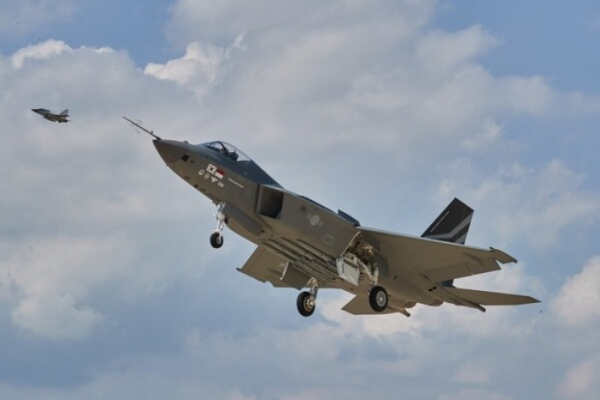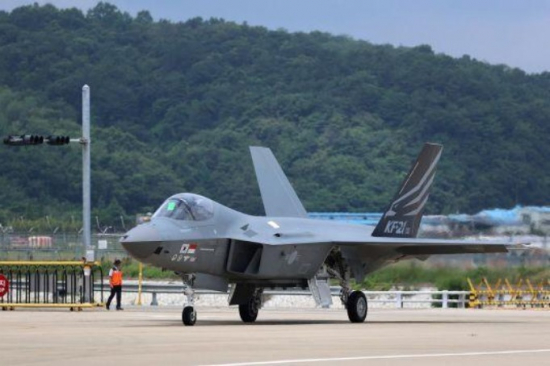Aerospace & Defense
Korea's domestic jet fighter KF-21 completes first flight test
Korea is poised to become the world's eighth country to develop advanced supersonic fighters
By Jul 19, 2022 (Gmt+09:00)
3
Min read
Most Read

KF-21 Boramae, South KoreaŌĆÖs first advanced supersonic jet fighter, successfully completed its first flight test on Tuesday more than six years after the 8.8 trillion won ($6.7 billion) development program started in December 2015. Through further tests and production, Korea is looking to become the worldŌĆÖs eighth entity to locally develop an advanced supersonic fighter.┬Ā
The test was carried out at the Air ForceŌĆÖs Third Flying Training Wing in Sacheon, South Gyeongsang Province, about 300 kilometers south of Seoul on July 19. KoreaŌĆÖs Defense Acquisition Program Administration (DAPA), a government organization that has led the development program, rescheduled the flight test from the morning to the afternoon considering weather and visibility.
The KF-21 prototype took off at 3:40 p.m., flew for 33 minutes, and landed at 4:13 p.m.┬Ā Seoul time at a speed of around 400 kilometers an hour. The jet fighter was equipped with four mock-ups of Meteors, European active radar-guided beyond-visual-range air-to-air missiles, during the flight.┬Ā┬Ā┬Ā
DAPA will complete the first phase of the program by 2026 by conducting 2,000 test sorties. In the second phase from 2026 to 2032, it will produce a total of 120 KF-21 jet fighters to replace the aging fleet of F-4s and F-5s.┬Ā┬Ā┬Ā┬Ā
KF-21 measures 11.2 meters wide, 16.9 meters long and 4.7 meters high. It is a 4.5th-generation fighter, equipped with some functions of fifth-generation fighter aircraft stealth and active electronically scanned array (AESA) radar, which detects and tracks enemy aircraft and ground and sea targets. KF-21 will be also armed with infrared search and track (IRST) and electro-optical targeting pods (EO TGPs) for target search and tracking and guidance of weapons.┬Ā

Korea will become the eighth entity in the world to develop homegrown advanced supersonic jet fighters after successfully completing the first phase of the program. Only six countries, the US, Russia, China, France, Japan, Sweden and a European consortium of the UK, Germany, Italy and Spain, have developed advanced supersonic fighters. KF-21ŌĆÖs localization rate is 65%.
The AESA radar boasts as high as 89% of localization rate thanks to R&D from the Agency for Defense Development of Korea. The country has focused on domestic development of key technologies after the US refused to transfer technologies of AESA radar, IRST, EO TGP and radio frequency jammers to Korea in 2015.
Korea Aerospace Industries Ltd. (KAI), a Korean aerospace and defense company, has joined forces with defense firms Hanwha Systems Co., Hanwha Aerospace Co., LIG Nex1 Co. and about 700 small-and-medium enterprises in Korea. The development project has advanced technologies in the Korean aerospace industries, as well as created numerous jobs, a DAPA official said.
The domestic jet fighter development plan was first announced in 2001 by then-president Kim Dae-jung. In 2010, Korea and Indonesia signed a memorandum of understanding (MOU) to jointly develop the jet fighters and hold 60% and 20% stakes of the programŌĆÖs shares, respectively. In December 2015, DAPA signed a development contract with KAI and started the program in earnest. KAI holds the remaining 20% stake in the program.
Meanwhile, the Indonesian government has yet to pay for 80% of the allotted shares which amounts to 800 billion won. Last November, the two countries reached an agreement that Indonesia would compensate 30% of the unpaid price with commodities such as palm oil but didnŌĆÖt specify the payment schedule.
Write to Dong-Hyun Kim at 3code@hankyung.com
Jihyun Kim edited this article.
More to Read
-
 Corporate investmentHanwha to boost defense, aerospace biz with $2.1 bn spending
Corporate investmentHanwha to boost defense, aerospace biz with $2.1 bn spendingMay 25, 2022 (Gmt+09:00)
2 Min read -
 Aerospace & DefenseLIG Nex1, Eugene plan $80.5 mn fund for Korea defense startups
Aerospace & DefenseLIG Nex1, Eugene plan $80.5 mn fund for Korea defense startupsMar 16, 2022 (Gmt+09:00)
2 Min read -
 Aerospace & DefenseHanwha, Poongsan, LIG Nex1 clinch $989 mn Saudi defense deals
Aerospace & DefenseHanwha, Poongsan, LIG Nex1 clinch $989 mn Saudi defense dealsMar 10, 2022 (Gmt+09:00)
2 Min read -
 War in UkraineKorea defense firms in spotlight amid Russia-Ukraine war
War in UkraineKorea defense firms in spotlight amid Russia-Ukraine warMar 07, 2022 (Gmt+09:00)
3 Min read -
 Aerospace & DefenseHanwha Defense secures land for K9 howitzer production in Australia
Aerospace & DefenseHanwha Defense secures land for K9 howitzer production in AustraliaFeb 23, 2022 (Gmt+09:00)
2 Min read -
 Aerospace & DefenseS.KoreaŌĆÖs defense exports to top $10 billion
Aerospace & DefenseS.KoreaŌĆÖs defense exports to top $10 billionJan 17, 2022 (Gmt+09:00)
4 Min read
Comment 0
LOG IN




